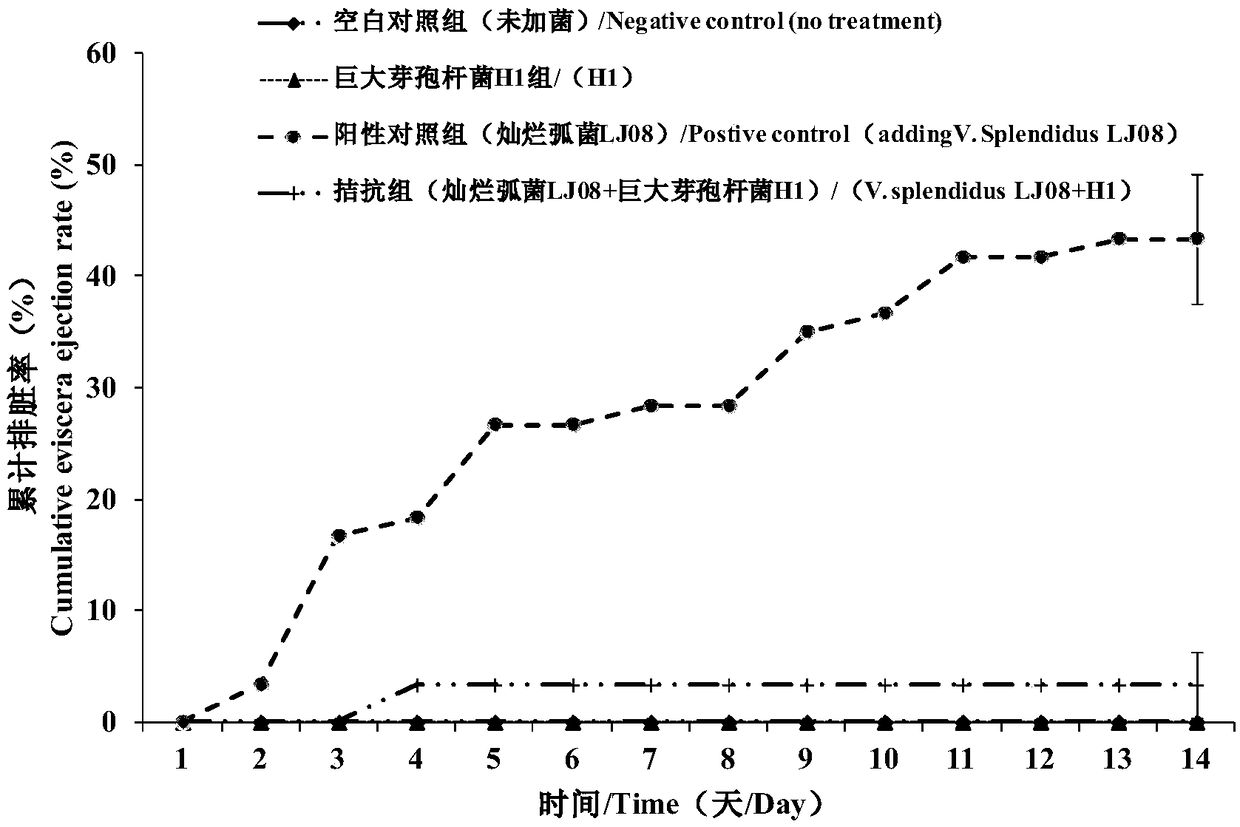Microecological preparation and preparation method for preventing and treating rotting skin syndrome of sea cucumber
A technology of micro-ecological preparations and japonicus imitation, applied in medical preparations containing active ingredients, pharmaceutical formulas, antibacterial drugs, etc., can solve the problems of enhanced drug resistance of pathogens, deterioration of breeding environment, drug residues, etc., to achieve prevention High efficiency, convenient use and low cost
- Summary
- Abstract
- Description
- Claims
- Application Information
AI Technical Summary
Problems solved by technology
Method used
Image
Examples
Embodiment 1
[0035] A microbial preparation produced by bacillus megaterium H1, the active ingredient of which is the thalline of bacillus megaterium H1 and its extracellular metabolites. Its preparation method is carried out according to the following steps:
[0036] (1) Strain activation: Streak and activate the Bacillus megaterium H1 strain stored at -80°C on tryptone soy agar medium, culture at 28°C until a single colony grows, and then pick a single colony and inoculate it on tryptone soy On the slant medium of agar medium, culture at 28°C for 24 hours to obtain the activated strain.
[0037] (2) Seed solution preparation: prepare tryptone soybean broth liquid medium according to conventional methods, its composition and composition: tryptone 1.5% (g / 100ml), soybean peptone 0.5% (g / 100ml), sodium chloride 0.5% (g / 100ml); In a 500mL Erlenmeyer flask, 200mL of tryptone soybean broth liquid medium was filled, and the pH was 7.6. Put it in a high-pressure steam sterilizer, and sterilize...
Embodiment 2
[0041] From January to March 2012, we conducted a 2-month experiment on the cultivation of imitation japonicus seedlings in Shandong Anyuan Aquatic Products Co., Ltd. The probiotics of Bacillus megaterium H1 are produced in a fermenter according to the method of Example 1, and the number of live bacteria reaches 3.5×10 10 CFU / ml, the bacterial solution is light brown and stored at room temperature. The experiment was carried out in 6 imitation japonicus seedling pools in the company's experimental workshop. A control group and an experimental group sprayed with Bacillus megaterium H1 microecological preparations were set up. Each group had 3 parallels, and each pool had a water volume of 8 cubic meters. Select healthy juvenile ginseng individuals (average body weight is 0.81±0.37g, body length 1.3-2.1cm), and the density of individuals is 0.5kg / square water body for 24 hours aerated culture. Ensure that the dissolved oxygen in the water body is >5mg / L, the water temperature i...
Embodiment 3
[0043] In December 2013, we conducted a 3-month winter breeding experiment in Qingdao Beibao Ocean Technology Co., Ltd. with preserved seedlings of sea cucumber. Bacillus megaterium strain H1 is produced by the company according to the method of Example 1 in the secondary fermentation tank, and the number of bacteria reaches 8.6×10 10 CFU / ml, stored at room temperature. The experiment was carried out in 9 imitation sea cucumber seedling pools in the circulating water workshop of the company. A control group, an experimental group fed with Bacillus megaterium H1 microecological preparations and an experimental group fed with Bacillus subtilis liquid were set up. sale (nominal 10 11 CFU / ml), each group of 3 parallel, wherein each pool of water is 6 cubic meters. Healthy juvenile ginseng individuals (average body weight 3.12±0.97g, body length 3.01-4.12cm) were selected, and the individual stocking density was 0.5kg / square water body. The breeding pond is inflated for 24 hours...
PUM
 Login to View More
Login to View More Abstract
Description
Claims
Application Information
 Login to View More
Login to View More - R&D
- Intellectual Property
- Life Sciences
- Materials
- Tech Scout
- Unparalleled Data Quality
- Higher Quality Content
- 60% Fewer Hallucinations
Browse by: Latest US Patents, China's latest patents, Technical Efficacy Thesaurus, Application Domain, Technology Topic, Popular Technical Reports.
© 2025 PatSnap. All rights reserved.Legal|Privacy policy|Modern Slavery Act Transparency Statement|Sitemap|About US| Contact US: help@patsnap.com



